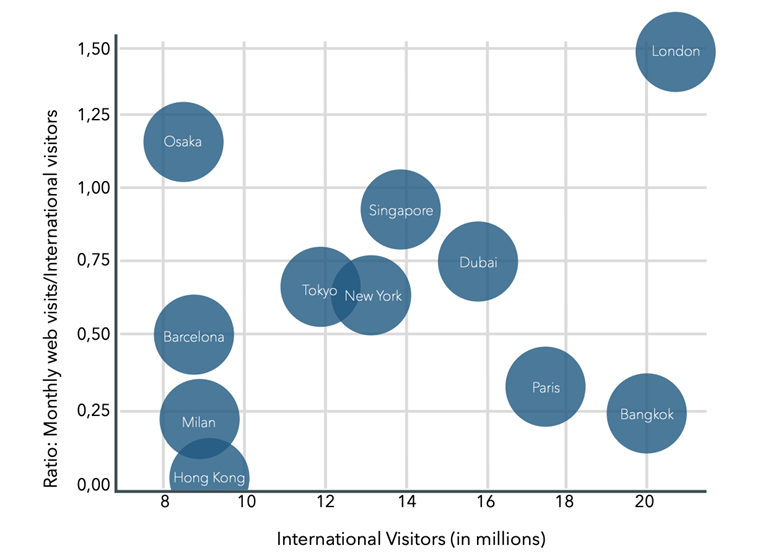With the unprecedented increase in tourism in recent years, destinations have been experiencing an impact on the social, cultural and economic environments. This is partly due to the increase in outbound demand, favorable economics, improvements in connectivity and visa allowances, and the recovery of some destinations previously suffering from security issues and crisis.
According to the Mastercard Global Destinations Cities Index 2018, in some destinations, such as Bangkok, the influx of international visitors surpasses the 20 million mark per year.With numbers only looking to increase, catering to the needs of this target and following the industry trends is extremely important for DMOs.
The most evident trend that dominates the travel industry is, undoubtedly, the digital one. As the world gets strongly connected through the internet, tourists rely on online tools to get inspired, plan and book their next trip. With so much potential coming from digital channels, destinations should be able to provide the perfect solution to their future and current visitors at all stages of the trip.
When analysing the most visited destinations in the world – by international overnight visitors – and the number of visits on their official tourism website, it is possible to see a change in scenarios. Keeping in mind the pace, the industry is evolving and developing ways to cater to tourists needs, especially online, is something to think about.

The graph above shows the correlation between the amount of web visits per tourist and the total number of visitors for the destinations analysed.
We can see top digital performers such as Osaka, Singapore, New York, Tokyo or Dubai, as they have a greater volume of web visits per tourist thanks to outstanding practises on their websites.
Digital best practices for destinations
Increasing the attraction of a destination’s website is possible, but only after checking some essential boxes.
The Smartvel Digital Best Practices from Top Tourism Boards uncovers key points that need to be followed in order to deliver a great user experience.
To start, due to the importance of destination content, these key points should be divided into two categories:
- General considerations
- Content related aspects
The general considerations involve language, visual and audiovisual content, together with mobile versions.
On the other hand, the content related aspects consider up-to-date or dynamic content, including local events; useful information for the tourist; content categorisation; trip planner feature, inspiring pre-populated guides; and geolocation of the content.
When hosting visitors from around the globe, it is important to show a good range of languages, allowing them to choose the most suitable ones and navigate without obstacles.
Using quality visual and audiovisual content helps to catch their attention and encourage them to keep on exploring the offers.
Finally, having a mobile or responsive version that is fully user-friendly, considering the increase of mobile searches over desktop, should not be taken for granted.
Meanwhile, the app allows travellers to be one click away from the information. Changing the aesthetic and functionality of a website does make a difference in the number of visits, retention and even conversion rates.
Content as loyalty
Moving past the general considerations, we find the content-related aspects. Content is the heart of any website. The amount, quality and organization, are some of the aspects that affect the success of delivering the message.
“With the online information overload, users are used to accessing multiple websites, therefore, encountering difficulties that slow their navigation process impacts on the power of any digital channel. More clicks, less interest.”
Keeping in mind the necessity of making the searching process efficient and addressing more than one stage of the customer journey, destinations should make important changes in both the quality of the content and the way it is displayed. Any reason that makes a website visitor change tabs is diverging the focus from what is really important.
When thinking about the quality of the content, it is important to consider the variety as well. With the online information overload, users are used to accessing multiple websites, therefore, encountering difficulties that slow their navigation process impacts on the power of any digital channel. More clicks, less interest.
The easiest type of content to find is the static one (top sights and attractions, restaurants, etc.), however, by showing only what is unchangeable, prevents tourists choosing from many other experiences the destination has to offer. Adding up-to-date dynamic content (exhibitions, sports events, concerts, etc.) gives users new opportunities and ways to enjoy their stay. Combining both static and dynamic enriches the overall offer and speaks to a bigger target.
Once there is a rich database of content, gathering the tools to display it properly determines how easy and personalised the navigation will be. Dividing the content into categories allow users to start filtering their search. From this point on, the customisation process should continue. Therefore, implementing tools such as a trip planner that enables users to save their preferred experiences, helps users to build their own trip itinerary.
With this, DMOs are able to deliver unique results, sharing only the right information at the right time, consequently becoming the top go-to source of information about the destination.
Overall, there are many ways of using content to reach different audiences and needs. Exploring alternative formats for each stage of the traveller’s journey allows DMOs to deliver a great user experience in all its channels.





